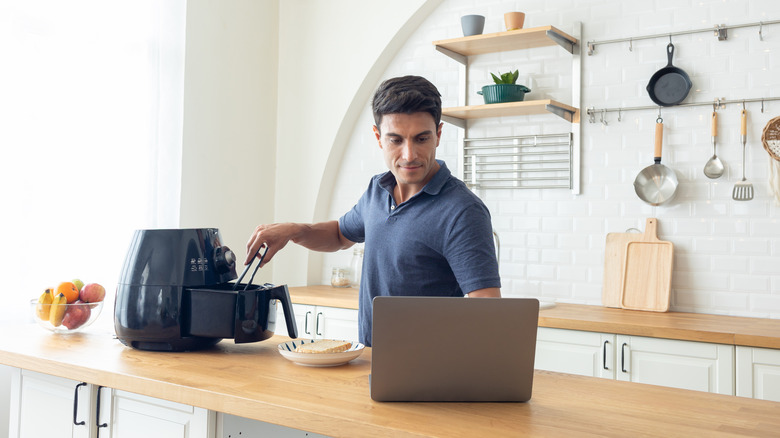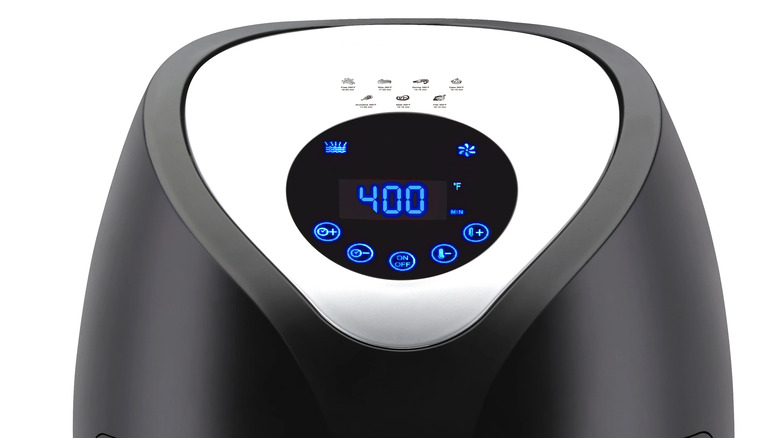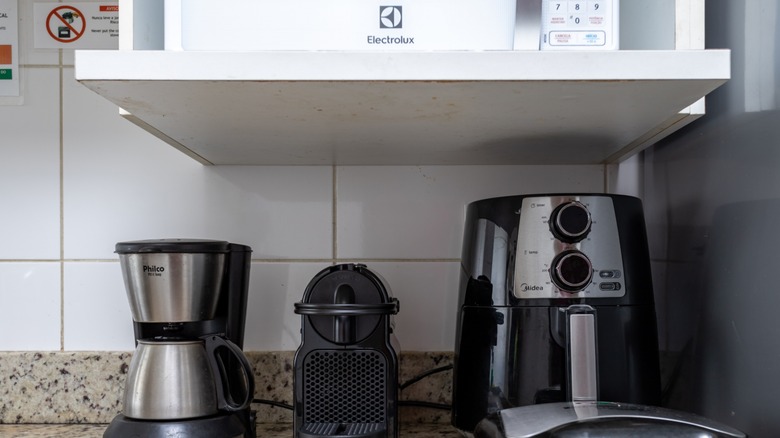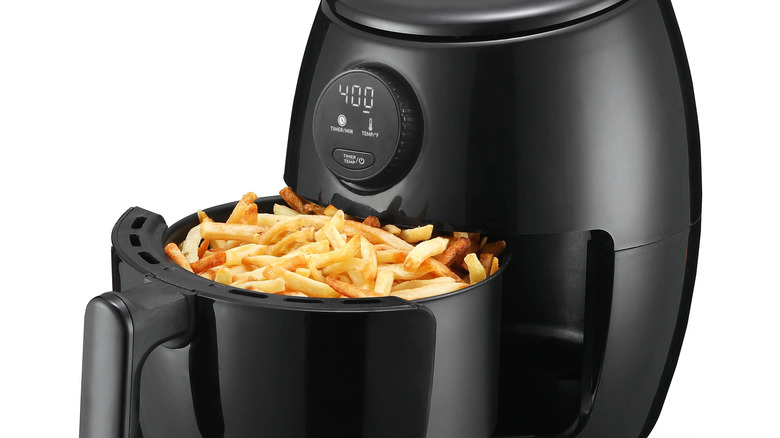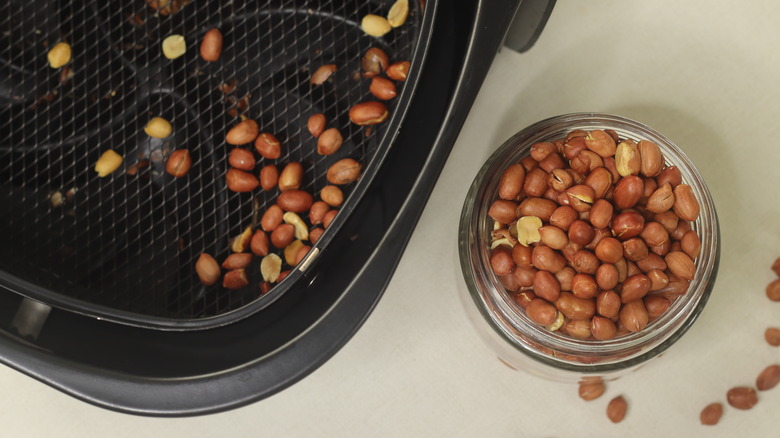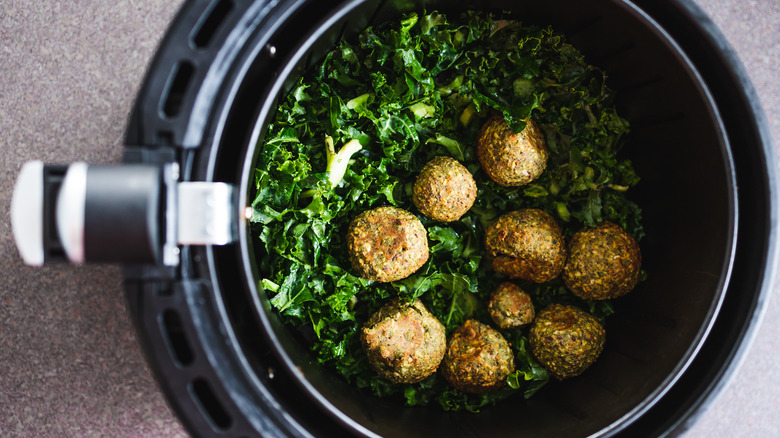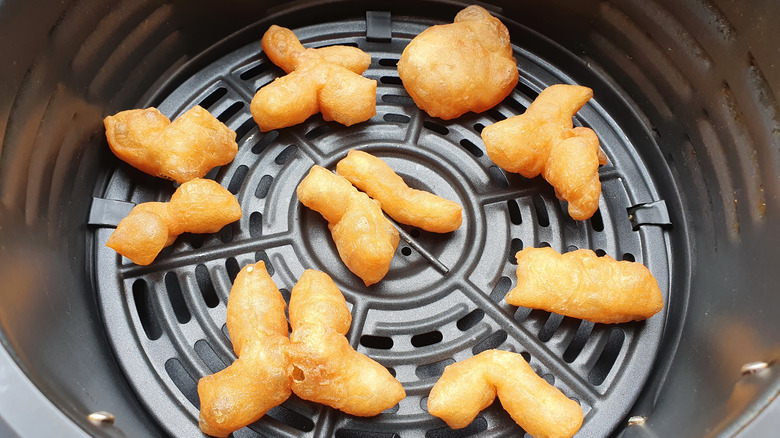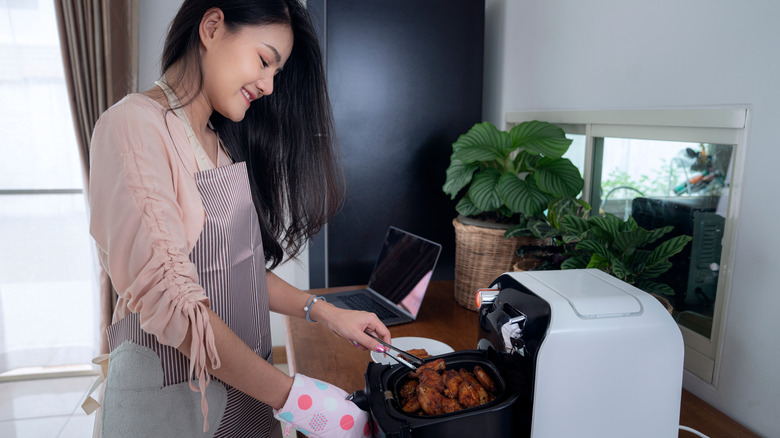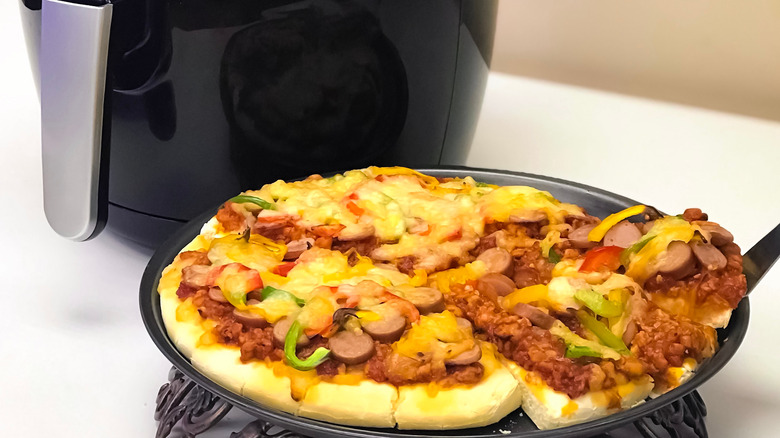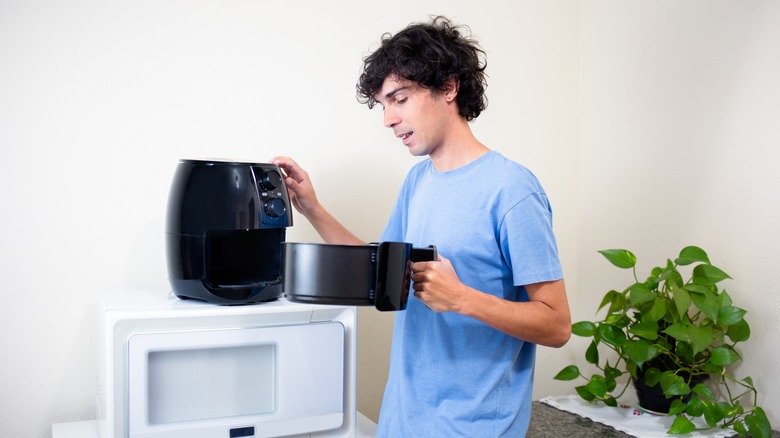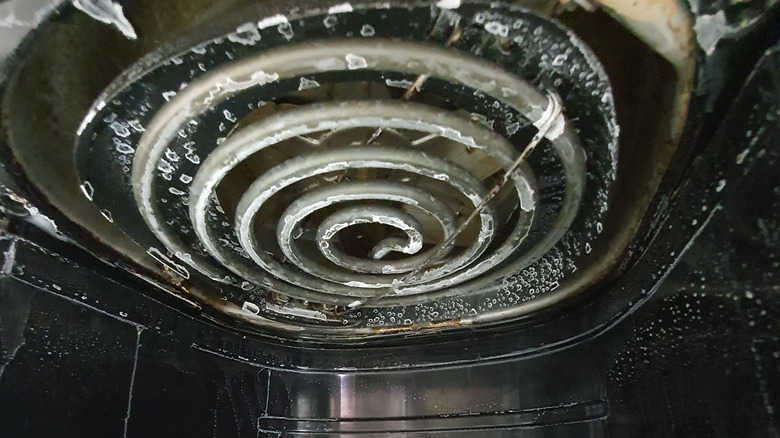The 12 Biggest Air Fryer Mistakes To Avoid
More Americans than ever are using air fryers for cooking food. NPD reports that in the years 2020-21, 25.6 million air fryers were sold in the U.S. — a 76% increase over the prior two-year span. Meanwhile, Allied Market Research has estimated the air fryer market will exceed $1.4 billion by 2026, which would be roughly a 60% increase versus 2018.
It's easy to see why air fryers are on the rise. These special countertop ovens are designed to give dishes a taste and crispy texture like a traditional deep fryer, without drowning them in cooking oil or batters (via WebMD). Using an air fryer lets you enjoy chicken tenders, french fries, and other familiar foods with far fewer calories. And considering deep fryer oils have been linked to serious health conditions such as heart disease, there are other potential benefits of an air fryer beyond how food tastes.
But like any other kitchen appliance, there are right ways and wrong ways to use an air fryer. While correct air fryer usage will give you a delicious dinner or snack, a mistake can mean an undercooked mess or worse. With that in mind, here are 12 common air fryer mistakes you're making and how to avoid them.
1. Not Reading the Manual
When you purchase an air fryer, the first thing you should do is read the manual. It's a long-running joke that "nobody reads the manual" — one with a basis, in fact. Yahoo! Entertainment reports a British study by the Civil Aviation Authority found 19% of adults rarely read the manual for a new gadget or appliance, and 26% rate the manual as the least enjoyable experience. It's not just electronics, either, as Bristol Street Motors found nearly two-thirds of car owners first go to sources other than the manual when they have a problem.
And we get why you won't want to. A study by the University of Texas of El Paso found many reasons why people don't read the manual, including that it's boring or hard to understand. Once a shiny new gadget arrives, it's much more fun to play around with it than read something dull and confusing.
But the information in air fryer manuals is worth the read. For example, the Insignia Digital Control Air Fryer manual includes cooking recommendations, warnings, cleaning steps, and troubleshooting tips — all from the company that designed the device. If you've lost your manual, you can easily find it on the manufacturer's website or at places such as Air Fryers Online. Having a working knowledge before you turn the appliance on means you'll be making tasty food sooner.
2. Not Preheating the Air Fryer
Just like regular ovens and deep fryers, preheating an air fryer will usually produce the best results. An air fryer is essentially a countertop convection oven with a heating element and fans to blow hot air around (via U.S. News). Preheating the air fryer allows the air to circulate and heat the cooking area more evenly before you start. As Purvin Shah of air fryer manufacturer SharkNinja tells Insider, "Preheating maximizes both cooking and crisping results."
It should be noted that not every air fryer model recommends preheating. But even if the manual doesn't mention preheating, it's still a good idea — not just for taste but for food safety. As detailed by Houston Methodist, temperatures between 40-140 degrees Fahrenheit are those where bacteria and microbes grow the fastest, and thus to be avoided. Preheating appliances means food spends less time in this zone. Furthermore, cooking time recommendations are usually based on the appliance being preheated. So if you don't preheat, you're on your own for timing.
In most cases, it only takes 3-5 minutes to preheat your air fryer — a relatively small amount of time to ensure the safest and most delicious results. Consult the manual before you start since each model has a different preheating method. Some have a preheat button or even do so automatically, so make sure you choose the correct settings before adding food.
3. Not Leaving Enough Counter Space
Though the smaller size is a big draw for air fryers, they still need space to operate. Just like their larger convection oven counterparts, air fryers work by distributing hot air throughout the cooking area (via Insider). As such, a constant flow of air is needed for proper heating. As CHOICE notes in their convection microwave buying guide, this flow is achieved through ventilation. Air outlets and inlets allow the device to blow out the excess hot air, smoke, and fumes while pulling in fresh air (via Ask Air Fryer).
When you surround your air fryer with other gadgets or stick it in the back corner, it doesn't get enough airflow. This can cause overheating, which means burned food and a possible fire hazard, as well as a buildup of potentially harmful fumes.
Leaving a little counter space around your air fryer means better, less dangerous cooking. Trusted Reviews recommends leaving at least 5-8 inches of space around all sides of the fryer for sufficient ventilation — you might even want to consider placing your cooker near an open window. Air Fryer Queen also suggests putting something underneath the appliance, such as a silicone mat or wood cutting board, to protect the countertop from excess heat.
4. Using the Wrong Oil Amount & Type
Although they go by the name "air fryer," these cookers don't always get by on air alone. The Food Network notes adding a little bit of cooking oil will help give your food the same crispiness and golden-brown hue as a deep fryer. The trick is knowing how much oil to use and what types are best.
Let's start with how much. MetroUK suggests 1-2 teaspoons of oil or a quick spritz of cooking spray for most recipes. Less than this won't give you the desired deep-fry-esque results, while too much oil will drip into the bottom tray, creating messes and possibly causing smoke. This leads us to what oil to use in an air fryer. Per U.S. News, the typical air fryer has a cooking temperature of approximately 400 degrees. However, data provided by Very Well Fit shows many popular cooking oils — such as canola oil, extra-virgin olive oil, and butter — have smoke points at or below this temperature. So if you use them, smoke and burning are far more likely. Look for options that have a smoke point above 400 degrees, like corn oil, sunflower oil, and refined oils.
One last note: if your air fryer basket has a nonstick coating, never apply cooking spray directly to it. Consumer Reports explains these sprays create a hard-to-remove film that eventually damages the coating. You don't want food to stick to the basket and cause even bigger issues.
5. Putting Too Much in the Air Fryer Basket
We know many people are tempted to stack food in their air fryer basket to fit more when a crowd is over. Unfortunately, doing this is begging for problems. As previously discussed, air fryers work by circulating hot air to cook food and make it crispy (via Insider). By extension, air needs to hit the food for it to cook and brown. UNL Food notes that by overfilling the basket, the hot air can't reach all the food, so the contents won't cook uniformly. So by piling french fries to the brim, many of them will likely end up lukewarm and limp, instead of hot and crispy.
The key is to buy a large enough air fryer to accommodate regular cooking needs and cook in batches if more is needed. Per CNET, the rule of thumb is that your air fryer size should be at least one quart per person. So if you're usually just cooking for yourself, a one-quart air fryer should be sufficient. For a household of four, get a fryer that's four quarts or larger, and adjust upwards if you frequently host friends or family. Air Fryer Eats adds you should also consider what foods you want to make, as certain dishes will only work in a larger model.
6. Cutting Food Too Small
You don't want to spend time prepping a great air fryer meal only for it to fall through the cracks. Although there are several types of air fryers, Consumer Reports notes the basket fryer is the most popular design. These gadgets use a bin that has either perforated holes or wire mesh on the bottom, which improves airflow while letting excess oil, fats, and moisture drip out (via Blue Jean Chef).
Those aren't the only things that can escape, though. It's tempting to slice fries and vegetables into small chunks to shorten cooking time and make them crispier. After all, according to the rate of reaction principle, small pieces of food cook faster thanks to a higher surface-to-volume ratio (via SPM Chemistry). But if you cut pieces smaller than the holes they'll end up in the bottom tray, along with other gunk.
Although the holes vary in size depending on the air fryer, a good guideline is to make sure every piece is at least ¼-inch in all directions. If you're not sure, place the food pieces in the basket and shake it over the counter or sink to see if anything drops through. Consumer Reports suggests another option is to get a tray air fryer. Similar to a toaster oven, they have a rack on which you can place baking trays, though if you do the times and temperatures might need tweaking since the underside won't cook as fast.
7. Adding Lightweight Foods and Dry Spices
Another major air fryer cooking mistake is not adjusting for lightweight foods and spices. The air circulating inside the fryer blows rapidly to distribute heat: Air fryer manufacturer Philips estimates it's moving at 70 kilometers per hour, or 44 mph. If you're wondering how fast that is, the National Weather Service says winds of 39 to 46 mph are fast enough to make a car veer while you're driving.
If a 44 mph wind can alter the course of a vehicle, think what it can do to food. It's no wonder Reader's Digest lists lightweight foods such as leafy greens and bread on their "avoid" list for air fryers. Since these items don't have enough heft to stay put, they move around a lot, cooking unevenly and creating big messes. Spices, herbs, and breadcrumbs run into the same problem. Dr. David Ludwig notes that dry spices will blow around since nothing is holding them in place. And you want to season your food, not the basket and heating element.
To enjoy these foods in an air fryer, Air Fry Anytime advises using toothpicks or a metal rack to keep lightweight foods from going airborne. As for spices, add a little bit of cooking oil to foods that the spices can stick to — or mix the spices into the oil before applying it. With a little ingenuity, you can avoid settling for bland, dense meals.
8. Cooking Foods with Wet Coatings
Wet coatings, known more widely as batters, are a deep frying staple. After all, what are onion rings and fried chicken without the batter? But sadly, batters don't translate well to an air fryer. To understand why, first we need to look at how wet coatings work in hot fryer oil. Science Meets Food explains that in a fryer, the Maillard reaction — which gives fried food its distinctive flavor, crispy coating, and brown color — is achieved through heat and dehydration. In a deep fryer, the oil provides the heat; the batter provides moisture to steam off while forming a seal that prevents the main food from drying out.
But in an air fryer, the Maillard reaction is spurred via the movement of hot air. And as Food Network details, while hot oil will "set" batter quickly, rapid air circulation doesn't do the same. The result is that your wet coatings will drip through the holes in the fryer basket bottom. You'll end up with a big mess to clean — not to mention wasting a perfectly good batter.
If you want the battering effect in an air fryer, Food Network proposes using a mixture of flour, breadcrumbs, and eggs. This will create a crunchy coating while setting much better in a convection-style cooker. Reader's Digest adds that reheating pre-cooked battered foods, such as frozen chicken tenders and fish fillets, is fine to do since the coating has already set.
9. Not Moving Food Around
The air in your fryer shouldn't be the only thing moving while you cook. The science of air fryers and their larger convection oven counterparts is that rapid air circulation helps spread the heat (via CNET). So it's easy to assume you can just place food in the basket and leave it until the timer goes off. But as the experts at America's Test Kitchen note, there's only so much space inside a countertop air fryer for air to move around.
In addition, the heating element is usually above the basket, meaning heat is blasting directly on top of your food. And although the holes or mesh on the bottom allow some airflow, the food still needs something solid to sit on. When you add it all up, there's a good chance food will cook unevenly if left stationary.
Therefore, it's vital to move food around so every square inch gets equal exposure to heat. About halfway through the cooking time, flip larger pieces of food over, and shake or toss smaller items. Even major air fryer makers such as Philips explicitly recommend some movement, so things come out evenly cooked and crisped. This is also the perfect time to check on your food and see if adjustments are needed to prevent overcooking or undercooking.
10. Limiting the Foods You Cook
Everyone has their favorites when it comes to fried foods, whether that be french fries, seafood, doughnuts, mozzarella sticks, or some other creation. When you get an air fryer, it's easy to stick to what you know, especially if you don't feel confident in the kitchen. You're not alone in that regard — as SWNS Digital reports, a survey by OnePoll found 56% of American adults admit to regularly screwing up simple meals, and according to Hindustan Times, the average British household only knows how to make four different dishes.
But by limiting what air fryer recipes you cook, you could be missing out on a new favorite. As cooking experts have told Insider, the possibilities for air fryer cooking are just about endless. You can make pizzas, cookies, falafel, or macaroni and cheese with a little extra crunch. A bigger air fryer gives you even more options. Air Fryer Eats observes that owning a large fryer allows you to cook a whole chicken or ham in one shot.
If you're having trouble getting your creative juices flowing, there are plenty of resources to help. Many air fryer manufacturers, such as Hamilton Beach and Black and Decker, have extensive online recipe books available for free. There are also a smorgasbord of air fryer cookbooks for all user levels — as the numerous recommendations by Food Network suggest — let your imagination run wild.
11. Not Checking on the Air Fryer
It's important to remember that an air fryer isn't a gadget you can "set and forget." While the design of conventional ovens is fairly standard, there are a lot of air fryer designs: At Air Fryers Online, you'll find the manuals for more than 80 models and counting — all with different heating elements, basket sizes, fan speeds, and settings.
This means there aren't hard and fast cooking rules when it comes to air fryers. The recommendations in the manual are good starting points, but mileage can still vary based on what you're making and what fryer you're using. And cooking something for the right amount of time is a must. Undercooked food wouldn't taste as good — and as BetterHealth Channel reminds us, it's also a safety issue. Conversely, overcooked food can end up burned and just as inedible.
So be sure to check on the air fryer periodically, just like you would a deep fryer, stovetop pot, or just about anything else in the kitchen. If you're air frying meat, you might consider using a meat thermometer to ensure it's cooked all the way through (via Safefood). Don't worry about letting all the heat out, either — Cook Smarts remarks that air fryers heat up fast enough, so briefly opening them won't have a significant effect.
12. Not Cleaning Your Air Fryer
We know washing dishes and appliances is a lot less fun than cooking. That's not just speculation — in a 2019 survey by OnePoll, most respondents said they'd rather clean the toilet or take out the garbage, than scrub dirty dishes by hand (via Cision PR Newswire).
But debris will build up in an air fryer over time if left unchecked. Consumer Reports notes that oil, fat, and grease can drip into the bottom tray or spatter on the heating element. Food bits may also get stuck in the basket perforations or scatter around the interior. This debris can cause burning, foul odors, and smoke. New Dynasty Pacific Grove restaurant adds that dirty air fryers are a health hazard. For example, if you undercooked meat, salmonella or E. coli can remain in the fryer, infecting future dishes and causing illness.
Experts recommend you clean your air fryer after each use, both for safety reasons and because they'll be easier to clean if gunk hasn't set in — but remember to let the fryer cool first. Scrub the insides and any removable parts using dish soap, warm water, and a non-abrasive sponge or cloth. If you just cooked food with strong odors, let components soak for an hour so those odors don't stick around. Stuck food particles can be removed with a toothpick, wooden skewer, or soft bristle brush. A little elbow grease now will save you a lot of caked-up grease later.

